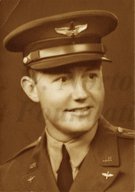
|

|
|
|
|
He was born in West Point, Mississippi, the son of John Evans Dorroh, a World War I veteran, and Jeanette Harkins Dorroh of Macon, Mississippi. At that time his father was a banker in Melville, Louisiana. "We lived pretty good," Walter recalls of life during the Depression, when the family had electricity, a telephone, refrigerator, radio, and nice cars. He later worked for a bank in Crestview, Florida. Walter grew up in New Orleans and was educated at all-male Fortier High School, graduating at age 16. At LSU he earned a degree in business administration in June of 1941. Meanwhile, his father purchased a bank in Crestview, Florida, remaining there until after World War II, when he sold it and returned to New Orleans. Walter entered the U.S. Marine Corps in November of 1941, but failed his physical because of a "bad leg" and was released. After December 7, 1941, he was accepted as an aviation cadet and sent to Montgomery, Alabama for basic training, then to South Carolina for primary and basic flight training. At Albany, Georgia he completed advanced flight training and received his wings in November of 1942 in the U.S. Army Air Forces. At Barksdale Field in Bossier City, Louisiana he trained in B-26s. He was sent to North Africa in January of 1944 where he flew bombing missions from Sardinia, Italy and then from Corsica, mainly targeting railroad yards, railways, and factories. He was assigned to the 318th Bombardment Squadron, with 12th Air Force. On of his most hazardous missions his unit lost two of six planes. Thirty-six aircraft went on most missions. "There would be six planes in a flight and there would be six flights," he recalls. They flew usually missions around 10,000 feet. Missions often lasted less than four hours. German fighters were rarely a problem, he reports, but flak was a major concern. He recalls that neither he nor any man on his plane was hurt. His homecoming was delayed when the U.S. Air Forces increased the number of mandatory missions from 40 to 50 and then to 60. He completed 59 missions, 52 in B-26 bombers, and seven in B-25's. Walter returned to America in January of 1945, arriving in Boston. He "checked in" at Fort McPherson in Atlanta, where he was given leave, which he spent in Fort Lauderdale, Florida, before his assignment to Eglin Field near Fort Walton Beach, Florida. There he taught other pilots how to fly B-24s, B-17s, and other aircraft. By May of 1945 he had earned enough points for discharge as a first lieutenant. He says he did not consider the military as a career. "I got in the service because we were in a war and I felt like I should go but my biggest concern was just doing my job and getting out," he recalls. He went to work in his father's bank in Crestview, Florida as a teller, then as cashier. He worked in a New Orleans bank, purchased a bank in Shubuta, Mississippi, then another in Olla, Louisiana. In 1969 he sold the Olla bank and purchased the Bank of Jena, soon sold it, then purchased the bank in Mansfield, where he's remained ever since. On April 16, 1952 he married Adrienne Prince. (They would have three children. Walter now has ten grandchildren.) Adrienne passed away in September of 2003. In 2004 he married Florence Collins, whom he had known in Crestview. |


